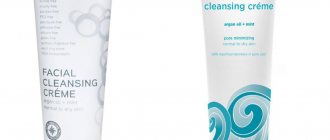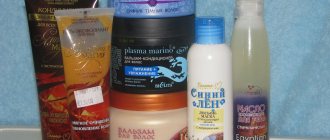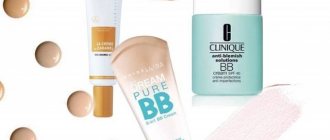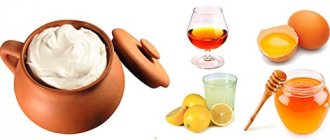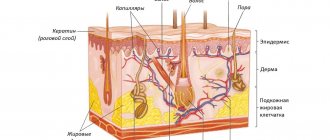The harmful effects of ultraviolet radiation have been known for a long time, which is why sunscreen is perhaps the first thing people think about when summer comes. But in winter, creams with ultraviolet protection are practically not used, believing that there is no need for it in cold weather. This is not so. In winter, the sun, although it does not heat as much as in summer, ultraviolet radiation does not disappear anywhere. In this article, we’ll tell you why you need to use a cream with ultraviolet protection even when it’s snowy and cold outside, and we’ll help you choose the right SPF cream.
Wash your face regularly (and thoroughly)
It's no surprise that minimizing pores starts with good skin care, and one of the easiest ways to minimize pores is to always cleanse them thoroughly. However, according to a GH study, 12% of women do not use facial cleansers regularly. “When dirt clogs pores, they expand and appear larger. So it's important to always cleanse your face with a gentle cleanser, especially before bed, to remove excess dirt and oil, explains Margarita Lolis, MD, a dermatologist in Hackensack, New Jersey.
“To cover all areas of the face, including the hairline and around the nose, where dirt can accumulate and clog pores, apply cleanser from the middle of the face up, then down the hairline and around the perimeter just below the chin,” says senior beauty lab chemist Good Housekeeping Institute Sabine Wiesemann. Using a facial cleansing brush has shown in GH Beauty Lab testing that it can help provide an even deeper clean.
In addition to daily cleansing, always use clean makeup brushes (clean them at least once a week) and never touch your face with your fingers. Your complexion (and your makeup brushes!) will thank you.
What is important to know about solar radiation
A reasonable dosed amount of ultraviolet rays is beneficial and necessary for the human body. It's important not to overdo it. Prolonged exposure to the sun without a protective agent damages the lipid barrier and immune system, slows down microcirculation, provokes dryness, hyperkeratosis and photoaging, while the complexion becomes dull and wrinkles appear. The dose of solar radiation accumulates in the body throughout life. Severe burns are especially harmful when blisters form on the skin.
Exfoliate your skin twice a week
Unlike cleansing alone, exfoliation helps remove and cleanse dead skin cells that can clog or block pores. "Exfoliation can be achieved in several ways, both physical (such as facial scrubs or a cleansing brush) and chemical (products with gentle acids that promote cell regeneration)," says Joyce Imajierobo-Ip, MD, a Dedham dermatologist. , Massachusetts, and consultant for HydroPeptide.
Look for gentle cleansers that contain low concentrations of salicylic (0.5-1%), lactic or glycolic acid (2.5-5%), which will stimulate cell turnover and keep pores clear.” You can also try using a prescription topical retinoid, which can increase cell turnover, thereby exfoliating pores and making them appear smaller.
How to choose a winter care cream
If in summer the number one task is to actively moisturize the skin, then in winter nutrition and protection come first. Face cream for the winter should:
- enrich the skin with vitamins;
- restore skin and promote renewal;
Should your skin be nourished or moisturized in winter? - restore water and fat balance;
- strengthen the barrier.
To find a suitable product, we carefully study the composition of winter cream and pay attention to its texture.
Winter creams are richer and denser in texture. © Getty Images
Compound
In your winter product, look for at least one of these ingredients (preferably 2-5):
- vitamins , , D, , F - they nourish the skin and make it more resilient;
- collagen, elastin - the aging process begins with a deficiency of these fibers, the skin becomes faded, loses turgor, and wrinkles appear on it;
- microelements magnesium, calcium, zinc - they ensure the active functioning of cells;
- oils, fats, ceramides - create a protective shell, smooth, soften the skin, make it more elastic;
- plant extracts - saturate the skin with moisture and nutrients;
- panthenol, allantoin - soften and soothe.
Moisturize your skin twice a day every day
Source here and below: Pexels
You already know what can happen to your skin if you stop moisturizing it (dryness, flaking, irritation). Enlarged pores are another problem. "It's important to use a high-quality, non-comedogenic facial moisturizer twice daily," says Dr. Imajierobo-Ip. Regularity is key in this case, so you should apply the product morning and evening. "If you leave your skin without hydration, it will react by producing excessive oil, which can clog your pores," he says.
Top 8 best winter face creams
The best face cream for the winter - what is it? It's different for every girl. But you can certainly find it in this collection, lovingly compiled by the editors.
Let's live until spring: allergies to cold
Ultra Facial Cream, Kiehl's
We have repeatedly included this product in the top of the best. It contains antarcticin, a microorganism that has the ability to survive at extremely low temperatures. And thanks to the content of squalane and vegetable oil, the skin becomes softer and more moisturized.
Triple Lipid Restore 2:4:2, SkinCeuticals
Thanks to the high concentration of ceramides and fatty acids, omega-3-6 promotes excellent skin protection from aggressive environmental factors and fights the signs of aging - loss of firmness and elasticity. This cream will protect your facial skin from frost.
Day face cream “Nourishing facial care “Luxury nutrition”, light texture, L'Oreal Paris
Ideal for dry skin, which suffers most from strong winds and temperature changes. The formula with calcium and white jasmine extract is easily absorbed, softening the skin and restoring its feeling of comfort. This cream is definitely what your skin needs during the winter!
Moisturizing cream-gel for normal and combination skin “Moisturizing Expert”, L'Oréal Paris
A million moisturizing molecules, vitamins B5, E, minerals - the composition has everything to keep your skin fresh, moisturized and soft. This cream is one of the best for winter for combination skin. It combats dryness and can be used all year round, not just in winter.
Nourishing hyaluronic aloe cream for dry and sensitive skin, Garnier
It is believed that in winter, fatty cream is most relevant. But if the fluid contains organic aloe vera and hyaluronic acid, use it without hesitation! These are time-tested moisturizing ingredients. The cream is quickly absorbed and instantly fills the epidermis with moisture. Suitable even for very dry and sensitive skin.
Intensive care cream to protect very dry skin Nutrilogie2, Vichy
In addition to thermal water and valuable jojoba, apricot and macadamia oils, it contains sphingolipid and vitamin E, helping to restore the lipid barrier of the skin. A savior for winter - moisturizes, eliminates the feeling of tightness and discomfort. And this is, rather, not even a nourishing, but a protective winter face cream.
Intensive nourishing cream for skin restoration Nutritic Intense, La Roche-Posay
Contains lipids that dry sensitive skin lacks. A soft, enveloping cream protects the skin from aggressive influences in winter, softens, and eliminates the feeling of tightness, burning and tingling caused by dryness.
Nourishing cream for dry skin Nutrix Royal, Lancôme
Gently cares for dry and very dry skin, filling it with moisture and energy. Vitamin C, royal jelly and hazelnut extract in the product nourish the skin and restore its protective functions, which is so important in winter.
Apply sunscreen every day
Daily use of a broad-spectrum sunscreen with SPF 30 or higher is an essential part of any skin care regimen for healthy skin and anti-aging, including preventing enlarged pores. “Ultraviolet radiation not only causes sun damage like wrinkles and dark spots, but it also breaks down collagen and elastin, causing pores to widen,” says Dr. Solis.
“The best way to prevent enlarged pores is to protect yourself from the sun.” Some sunscreens can make skin look shiny or oily by emphasizing pores, so choose an oil-free or lightweight gel formula with a matte finish.
Proper hand skin care in winter
When it's cold, the handles react instantly. The skin becomes flabby, peels, and microcracks appear. To restore its healthy appearance and make your hands soft and tender, use a few simple life hacks.
- Go outside only wearing gloves.
- Regularly apply a fat-based or Vaseline-based moisturizer to your hands .
- Use regular Vaseline , which will perfectly protect the skin of your hands from drying out in the cold.
- Wash your hands only with moisturizing soap under running warm (not hot!) water .
- Make hand masks using natural oils, massage the skin with light movements, which will improve blood circulation and help the skin recover.
Choose a mask that suits your skin type
They're not just a good way to relax, face masks can also tighten your pores over time. “Home treatments such as facials and peels work with consistent long-term use,” says Dr. Imajierobo-Ip. Incorporate once or twice a week into your beauty routine. If you have large pores and oily skin, masks containing ingredients like clay or charcoal will work best for you.
For other skin types, "multitasking" by applying these formulas to the T-zone (forehead, nose and chin), where pores tend to be most visible, is best.
How not to harm your skin in winter
Protect yourself from wind and frost. If your hands can be hidden in gloves or mittens, then apply a special cream to your face that will protect you from the harsh cold. It creates a small film, so you will avoid chapping and dryness.
Take a proper bath. Avoid baths and showers that are too hot to maintain your skin's natural moisture levels. In winter, it is better to spend no more than 7 minutes in the shower; after leaving the shower, the skin is moisturized with a fat-based cream.
Humid microclimate. Regularly ventilate and humidify the air in the apartment. Maintain humidity between 30%-60%.
Consider laser treatment
To permanently reduce the size of your pores, see a dermatologist who can recommend professional laser treatments. “A series of treatments using non-ablative lasers builds collagen, resulting in smoother skin and smaller pores,” explains Dr. Lolis.
Another option is Fraxel laser treatment, which resurfaces the skin and reduces the appearance of enlarged pores, explains Ellie Summers, a medical esthetician at Tribeca MedSpa in New York City. “Fraxel technology uses heat to create controlled microscopic wounds in the skin to stimulate the body to produce new collagen, resulting in a smoother texture and clearer pores.”
Types of sun rays and their effects on the skin
Ultraviolet rays are divided into 3 types:
- UVA rays (length – 320-400 nm). They are divided into long ones - UVA1 and short ones - UVA2. Reach the surface of the Earth. They are able to penetrate the upper and deep layers of the epidermis. In addition, UVA rays change the structure of DNA, increase the likelihood of genetic mutations and can cause skin cancer. They lead to hyperpigmentation, freckles, increased dryness of the skin and photoaging, and destroy elastin and collagen fibers. Such rays actively participate in tanning and cause burns. They are active at any time of the year. Solarium lamps emit UVA rays, which threatens structural changes in the skin.
- UVB rays (length – 280-320 nm). Reach the surface of the earth. Ultraviolet B rays penetrate only the upper layers of the skin, causing burns. They lead to photoaging and are considered a provoking factor in the development of skin cancer and eye damage. Maximum activity of UVB rays occurs from March to October, from 10 a.m. to 4 p.m.
- UVC rays (length – 100-280 nm). They have the strongest damaging effect on the body, but they are adsorbed by the ozone layer, so they do not reach the surface of the earth.



